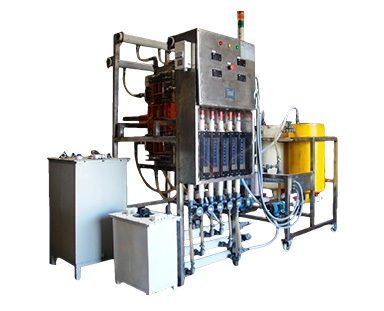Electrodialysis Application
Colloidal Silica Manufacture
Phase Transfer Catalysts Manufacture
Desalination of fruit juice
Removal of tartaric acid from wineDesalination of pharma / chemical intermediates
Desalination of cheese whey
Desalination of soy sauce
Production of amino acids from amino acid salts
Desalination of starch sugar, soybean saccharide, xylose and xylito desalination
Acid recovery from stainless steel pickling effluent
Recovery of electroplating solutions
Production of acid and alkali from inorganic salts/industrial waste streams
Acid recovery of aluminum foil pickling process
Production of organic acid from organic acid salt
Phase Transfer Catalysts Manufacture.
Preparing or purifying onium hydroxides of the elements N, S or P by Electrodialysis/ EDBM.
Stable or at least largely stable onium compounds, i.e. the onium compounds of the elements N, S and P, play a major part in many fields of chemical synthesis or analysis. The onium compounds of nitrogen in particular, i.e. the quaternary ammonium compounds, cover a wide spectrum of applications. The quaternary ammonium hydroxides, e.g. tetramethylammonium hydroxide (TMAH) and tetraethylammonium hydroxide (TEAH) are strong organic bases which have been known for many years. Such quaternary ammonium hydroxides have found numerous applications, for example for the titration of acids in organic solvents or as electrolytes in polarography.
Aqueous solutions of quaternary ammonium hydroxides, especially of TMAH, are often used as developers for photoresists in printed circuits and in chip manufacture. Often, however, the particular application demands that in addition to the abovementioned ammonium hydroxides, industrially available on a large scale, those carrying larger organic substituents be used, for example when employed as phase transfer catalysts or in the production of zeolites.
Many applications require the ammonium hydroxides to be of high purity. The high purity demanded relates to residual levels of halides, sulfates, carbonates and the like, for example in the manufacture of semiconductor elements. If ammonium hydroxides are used in the preparation of zeolites, the high purity relates particularly to as low an alkali metal ion level as possible.
PRODUCT LINE:
The quaternary ammonium hydroxides are prepared by Electrodialysis of a salt of a quaternary ammonium compound. The quaternary ammonium salts customarily employed in such processes comprise halides, carboxylates, carbonates and sulfates.
Examples of salts which can be Electrodialysed include:
- Tetramethylammonium chloride
- Tetramethylammonium bromide
- Tetraethylammonium chloride
- Tetraethyl-ammonium bromide
- Tetrapropylammonium chloride
- Tetrapropylammonium bromide
- Tetra-n-octylammonium bromide
- Tetraisopropylammonium chloride
- Tetraisopropylammonium bromide
- Trimethylhydroxyethylammonium chloride
- Trimethylmethoxyethylammonium chloride
- Tripropylhydroxyethylammonium chloride
- Tripropylmethoxyethylammonium chloride
- Triiisopropyl-hydroxyethylammonium chloride
- Triisopropylmethoxyethylammonium chloride
- Dimethyldihydroxyethylammonium chloride
- Methyltrihydroxyethylammonium chloride
- Phenyltrimethylammonium chloride
- Phenyltriethylammonium chloride
- Benzyltrimethylammonium chloride
- Benzyltriethylammonium chloride
- Dimethylpyrrolidonium bromide
- Dimethylpiperidinium bromide
- Diisopropyl-imidazolinium bromide
- N-alkylpyridinium bromide and the like.

Examples of quaternary phosphonium halides include
- Tetra-2 0 methylphosphonium bromide
- Tetramethylammonium bromide
- Tetraethylphosphonium bromide
- Tetrapropylphosphonium bromide
- Tetrabutylphosphonium bromide
- Trimethylhydroxyethylphosphoniumbromide
- Dimethyldihydroxyethylphosphoniumbromide
- Methyltrihydroxyethylphosphoniumbromide
- Phenyltrimethylphosphonium bromide
- Phenyltriethylphosphoniumbromide or benzyltrimethylphosphonium bromide
The Electrodialysis stack comprises electrodes (anodes and cathode) at both ends of the stack and a series of membranes and seals which form a multiplicity of separate volumes. A solution to be subjected to electrodialysis is fed in, as a rule, through a number of feeders, said number being defined by the number of the volumes of the cell units of the entire stack. Stacks forming the totality of the electrodialysis apparatus can. for example, include just one type of cell unit, but alternatively a number of different types of cell units can be present in each stack.
We can provide Pilot Plants as well large commercial plants for such applications.
